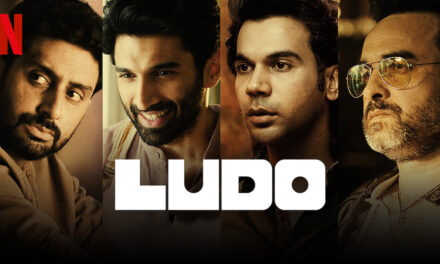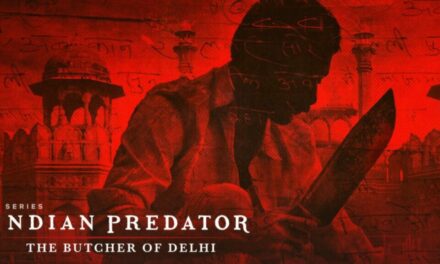Director: Terrie Samundra
Cast: Shabana Azmi, Satyadeep Misra, Sanjeeda Sheikh, Riva Arora, Leela Samson
Kaali Khuhi could be viewed as Netflix India’s Halloween release. The film opens on a dark, rainy night. We see a man approaching a long abandoned well (the Khuhi) in the middle of a field and breaking open its seal. There’s a dazzling shaft of light, after which a hand emerges out, pulling the terrified man in. A girl in a red dress is then seen climbing out of the well and walking eerily off into the night.
The film’s story is set in a village in north India. Darshan (Satyadeep Misra) is paying a visit from the city to call on his ailing mother. Accompanying him are his wife Priya (Sanjeeda Sheikh) and daughter Shivangi (Riva Arora). It soon becomes clear that all is not well in this house or at the village. Darshan’s mother (played by Leela Samson) exhibits strange behaviour and Shivangi often has visions of a mysterious young girl around the place, apparently a ghost. Things escalate further when this ‘ghost’ begins attacking Shivangi’s loved ones, taking lives in the process. To compound matters, there is also a strange epidemic that’s spreading around the village. The only person with any clue about this predicament seems to be Satya Maasi (Shabana Azmi), a village veteran. She suspects an old curse is back to haunt the village. The abandoned well from which the girl’s spirit appeared has dark secrets buried within and its now upto Shivangi and Satya to get to the bottom of it.
Kaali Khuhi gets most things right with respect to the mood and the ambience-pillars for any successful horror venture. A lot of the colour is drained out from the images (Sejal Shah with some terrific cinematography) and the heavy score (by Daniel B George) adds to create a real milieu of doom and gloom. The visuals themselves are highly impressionistic. Folks puking out black blood, an oft appearing buffalo (symbolizing Yama, the Hindu God of death) and the most audacious one of all, a womb with a throbbing foetus inside (this imagery was almost Lynchian) stay with you long after the credits roll. But where the film falls short is in its story.
The curse at the village originates from cruel instances of female infanticide that have dotted its history. We are given a back story about how this was a prevalent practice, and also what led to the ultimate sealing of the well, into which corpses of babies were flung. As you can probably guess, the spirit wreaking havoc now was once an unfortunate victim.
Revenge is a frequent theme employed by horror script writers. Think of a recent film like Stree, which though leaned towards the horror-comedy template, did also manage to keep us hooked through a solid revenge-based storyline. Kaali Khuhi sadly never evolves into something as complete. It’s a bundle of ideas, some good ones at that, but these fail to stitch together to form a cohesive story. A more meaningful comparison would even be a Tumbbad, a film that nailed its imagery just like Kaali Khuhi, but additionally also had a dark and gripping story going for it.
The attempt made with Kaali Khuhi is laudable. I liked the idea of a social evil being written into this narrative. Even more interesting was how the perpetrators of female infanticide were shown to be women in this story. There is also an alarming early scene set in present times, where Leela Samson’s character openly condescends Priya for birthing a girl, right in front of her daughter Shivangi. So you could say Kaali Khuhi works more in a symbolic way than a cinematic one. It sounds a word of caution that horrors of the past might not really be dead and could come back to haunt if the new generation didn’t stay vigilant.
Overall rating: 2/5










